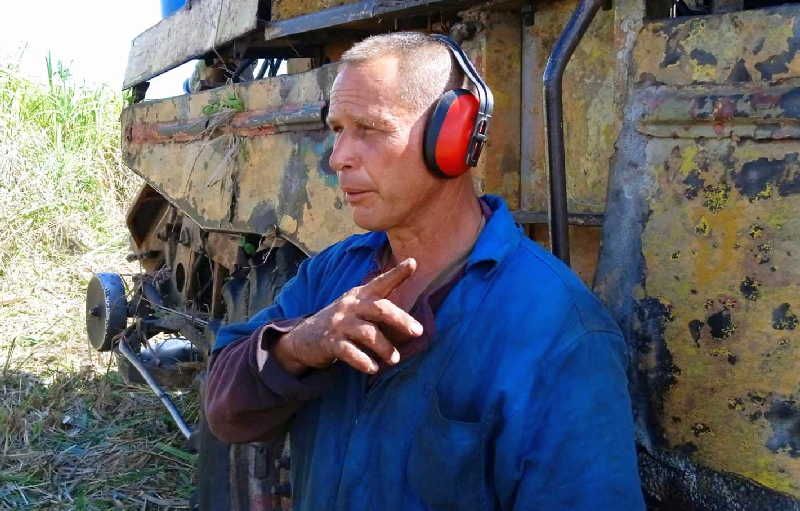Platoon 6 of the UBPC Guayos may be one of those that provide support to other cutting areas. (Photos: José Luis Camellón/Escambray).
More than lining themselves with gloves to try to escape unscathed from the attacks of the sun and the sting, the true art of Pedro Carmona Pérez and Wilber Rojas Rojas is in the skill with which they master the old KTP to succeed in that daily chore of cutting, in plantations where there are almost more weeds than cane and the palo blanco – an invasive species – is bidding to take over the fields.
The keys to mechanized cutting are the same as always: a work of will, of resistance we can say; always under the pressure of the daily task and the grind of the center. But this harvest, with more resource limitations than cane to grind, has become a quixotada for the campaign groups, a work of handsome men; in the particular case of operators, especially when the harvest is undertaken from the old and battered KTP.
It is the same horizon in which Platoon 6, of the Guayos Basic Cooperative Production Unit (UBPC), belonging to the Melanio Hernández Agroindustrial Company, operates, which provides raw materials to the plant of the same name, a group that puts its knee on the ground to carry out the harvest, under the leadership of Diana Forteza Rodríguez, one of the two women who lead groups of this type in the entity,
LIKE SPARK, LIKE PETER
Escambray He went to platoon 6, even with the warning that aspiring to interview the two operators was a difficult task; They are men of work and little talk, they warned. Reality surpassed the warning.
A native of Tres Palmas, in the municipality of Cabaiguán, Pedro Carmona Pérez was a boy when, following in his father’s footsteps, he found a youthful pastime in the combine.
It was a time when it was common to see, in the middle of the harvest, adolescents and young people linked to parental duties, perhaps ignoring certain work safety regulations; but, without a doubt, a practice that provided relief from work. In April 2024, that image barely exists in the landscape of the Sancti Spiritus harvest, a negative sign for the continuity of trades, where family roots have counted for a lot.
Pedro Carmona arrived at the cane field through that barrier. “It was what I saw since I was little, my dad was an operator, on weekends or every time he had a chance at school he would come to cut cane.” They were his first words in a minute-long interview, where he did not need to say that the press that morning put him in one of the great troubles of his life.
Between broken sentences, taking steps from one side to the other, as if looking for a gap to escape the journalistic encirclement, he dictated his work manual. “You have to do things for the team every day, that’s the only way it stays on the court, and the other thing is knowing how to cut, seeing how to enter the field, above all you have to tune up to deflect the white stick, the guineas, you find them in all the furrows and that destroys the blades.”
At 35 years old, Pedro has recorded 16 harvests; He speaks very little, but he cuts a lot of cane and rubs shoulders with the first operators in the Melanio Hernández company. For him, the harvest brings another peculiarity: his wife is the leader of the platoon and, although the rules of work apply in the field, it transcends that love survives the vicissitudes of that half-nomadic life in times of harvest.
The daily task of each machine is to cut 50 tons, he states and anticipates the other question. “The cane has to be very bad or a big break occurs to stay down. Personally, I prefer to snack all day, rather than be bordered by a break; You don’t win standing still, neither us, nor the platoon, nor the center.
“I like the KTP, it’s an old machine, but it doesn’t break much. How is it possible? Because I live above it, I maintain it by beating it myself; I also learned it with my father,” says the operator.
MY LIFE IS IN THE KTP
Turnkey, making adjustments to the cutting system, he found Escambray to Wilber Rojas Rojas, a 44-year-old operator with several harvests under his belt. “Fixing the machine, keeping an eye on any problems, is part of my job,” he says as he tightens a screw.
Before joining the combine, Wilber Rojas was a cane picker, boyfriend, mechanic, he passed the operator course and has worked in the UBPC Guayos platoon for 14 years.
“The cane is not like before, there is a lack of resources, parts, this harvest is a challenge,” he says. Like Pedro, he realizes that the interview is not his world, he seems eager to return to court. Further, Escambray He holds it for a few minutes.
“Weeds make the machine’s work difficult, it gets stuck, you have to stop, time is lost, the cutting is delayed; This is combined with material problems and the harvest becomes complicated. But here we are, under the bullets and always looking good with the help of other colleagues.
“I prefer this combination, I tried the most modern ones, the Case, I didn’t like it, I decided on the KTP, I’m used to it. This is day after day, I always look at the result, I review the machine’s problems, even at home I am still connected to the harvest. My life is in KTP, it is like my second daughter.”

How many days of harvest are left?investigate Escambray.
“You don’t know, it’s time that tells you,” he answers, almost about to start the combine to return to the court.
“The most likely thing is that when the cooperative’s cane runs out we will go to other places. In addition, we have a platoon leader who is also a cook, she pulls us along, she cares about us more than herself and we have to follow her. What if she cooks well? I eat two or three times. What I do tell you is that the Guayos platoon will continue cutting while the harvest is active.”
![]()









